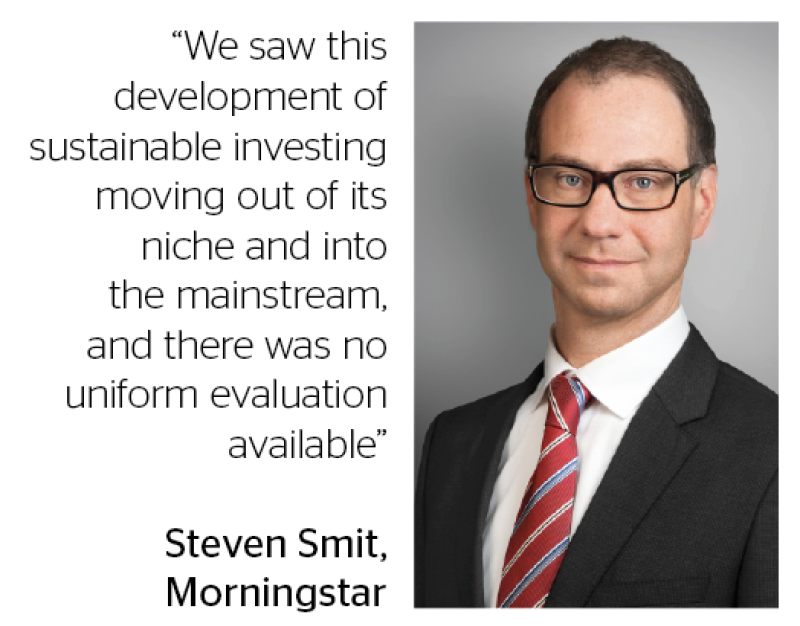While it is not the first rating effort to focus on funds’ environmental, social and governance (ESG) credentials, Morningstar’s arrival this March — in partnership with Sustainalytics — is unprecedented in its scale and reach. The pair have calculated ‘Five Globes’ sustainability ratings for around 20,000 funds globally.

“We saw this development of sustainable investing moving out of its niche and into the mainstream, and there was no uniform evaluation available,” says Steven Smit, head of sustainability at Morningstar. “If we would partner with a company like Sustainalytics, a great provider of specialised capability with no conflicts of interest, we could bring the space from the Dark Ages to some type of Enlightenment.”
Clients had questioned the ESG research house about fund ratings “for quite some time,” adds Cecilia Barsk, manager, advisory services at Sustainalytics. “As it is not our speciality, the opportunity to partner made a lot of sense. It really brings our research further up the investment chain.”
Following the ratings’ launch this spring, competition is on the rise. MSCI has launched a similar ESG product, while Fundquest has announced its entry. A host of start-ups are seeking to carve out niches.
“It’s good that other companies come in,” Smit says. “We try to lead, but there is quite a lot of missionary work to do and we cannot do it alone.”
Public push
One differentiating aspect of the Five Globes is that Morningstar has made them free to the public, unlike many of its institutionally targeted products. This reflects both the Chicago-headquartered firm’s strong retail brand, particularly in the US, but also an evangelical stance on building awareness and use of an ESG lens in investment decisions.
“We can only move the needle if we make it easily available and provide investor education alongside it,” Smit says.
Mixed reception
Asset managers have welcomed the arrival of independent ESG ratings, though a minority have been critical, especially ESG-focused funds that received weaker ratings. They take issue with the underlying methodology. A single rating cannot encapsulate funds’ strengths and weaknesses, they charge.
“The industry has shown great interest in how the ratings are assigned and could be used,” Smit notes.
Professional engagement with the ratings has been strong. Unique visits by advisers and managers to Morningstar’s sustainability website are notably higher than to those for its other initiatives. Retail use has been slower, inevitably.
Green bond players applaud the initiative, meanwhile. “When an established firm like Morningstar begins rating funds it sends a strong signal to the market that mainstream investors have begun evaluating investments in this way,” says Ashley Schulten, head of climate solutions, fixed income at BlackRock.
| From raw score to relative ranking |
||
| Morningstar’s rating process has two stages. It begins with a raw ‘portfolio sustainability score’. This is derived for all funds where Sustainalytics assigns a corporate ESG score to 50% or more of assets. The exercise is not limited to explicit sustainable/responsible investment approaches, though these generally do much better than conventional funds. Then Morningstar produces a sustainability rating from one to five globes. This is a relative measure that compares funds with peers (at least 10) and assigns ratings under a standard distribution. At launch 35% of rated funds were assigned a rating of three globes, 22.5% each a rating of two or four globes and 10% each one of five globes or one. “We assign the ratings on relative rankings within a fund’s category, which is a peer group of comparable funds. This could mean, however, that across categories a fund with a lower absolute score than another may end up with a higher rating. We provide both scores on our websites, but think the peer-to-peer sustainability rating is most relevant for selecting funds with similar investment mandates,” explains Steven Smit, head of sustainability at Morningstar. This is because some funds ranked highly within their sectors can achieve higher ratings than others with better raw scores but a weaker position in another sector. Even so, they make the raw scores “more relevant”, he argues. Although Morningstar does not actively upgrade or downgrade its sustainability ratings, each month around 15% of its rated universe sees its number of globes rise or fall. This mainly reflects changes in holdings refracted through their Sustainalytics scores. This rate of change is in line with Morningstar’s conventional fund ratings, Smit notes. The initiative does not rate government or municipal bond funds yet. Incorporating these is one of the initiative’s future goals. Others include increasing the proportion of funds’ assets that attract a score from Sustainalytics and factoring in a new family of sustainability indices that Morningstar is to launch soon. In addition, the partners will analyse the ratings’ stability and questions of their value, such as whether the distinction between three and four globes is adequate. |
||